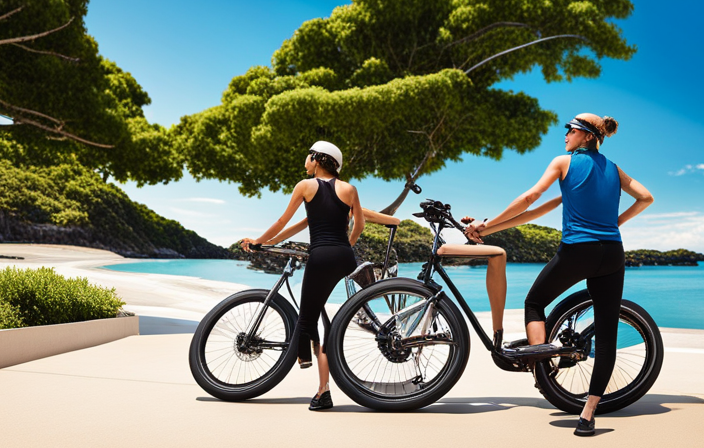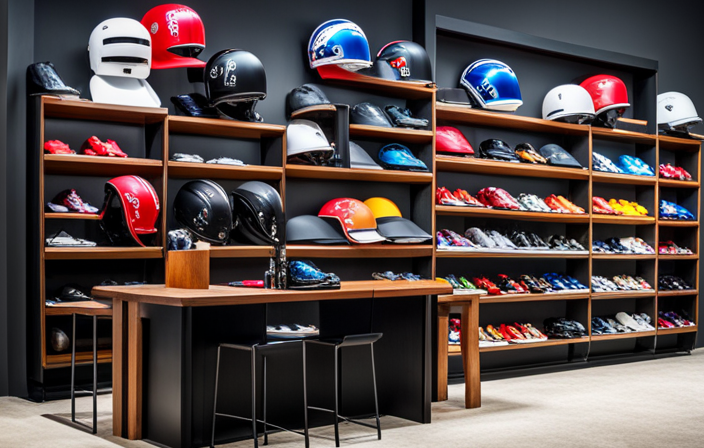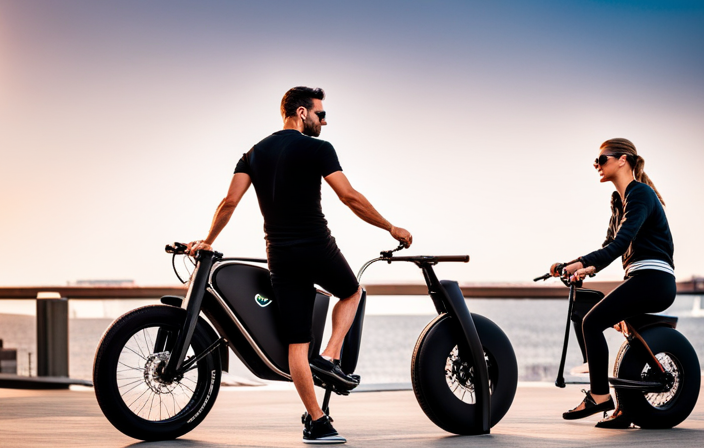Building an electric bike with a friction roller is like crafting a powerful steed that effortlessly glides through the streets.
In this guide, I will share the step-by-step process of creating your very own electric bike using the friction roller system.
We’ll cover everything from understanding the mechanics of this system to selecting the right bicycle frame, installing the friction roller, and adding essential safety features.
Get ready to embark on an electrifying journey as we explore the world of electric bikes.
Key Takeaways
- Electric bikes are eco-friendly and efficient, emitting zero greenhouse gases and reducing air pollution.
- Friction roller systems are easy to install, cost-effective, and have minimal impact on bike performance.
- When choosing a bicycle frame, consider the type of riding and body measurements for comfort and control.
- The installation of the friction roller and electric motor requires proper alignment and secure mounting, with the motor wired to the battery, controller, and throttle.
Introduction to Electric Bikes
Electric bikes, also known as e-bikes, are becoming increasingly popular due to their eco-friendly and efficient nature. These innovative vehicles combine a traditional bicycle with an electric motor, providing riders with a convenient and sustainable mode of transportation.
The introduction of electric bikes has revolutionized the way people commute, offering numerous benefits. Firstly, e-bikes are environmentally friendly as they emit zero greenhouse gases, reducing air pollution and contributing to a cleaner and healthier environment. Additionally, electric bikes are highly efficient, allowing riders to travel longer distances with less effort. The electric motor provides assistance when pedaling, alleviating the strain on the rider’s muscles and making uphill climbs easier.
With these advantages in mind, it is essential to understand the friction roller system, which plays a crucial role in the functioning of an electric bike.
Understanding the Friction Roller System
To understand how the system works, you’ll need to familiarize yourself with the mechanics of the roller and its interaction with the bike. The friction roller system is a key component in converting a regular bike into an electric one. Here’s a breakdown of the friction dynamics and the advantages of this system:
Understanding friction dynamics:
- The roller is made of a high-friction material, such as rubber, that comes into contact with the bike tire.
- As the bike moves forward, the roller applies pressure to the tire, creating friction.
- This friction transfers the rotational energy of the tire to the roller, powering the electric motor.
Advantages of the friction roller system:
- Simple installation: The roller can be easily attached to the bike frame, making it a convenient option for conversion kits.
- Minimal impact on bike performance: The roller system adds minimal weight and does not alter the bike’s existing drivetrain.
- Cost-effective: Friction roller systems are often more affordable compared to other electric bike conversion options.
Understanding the mechanics and advantages of the friction roller system sets the foundation for successfully creating an electric bike. Now, let’s move on to gathering the necessary materials and tools for the project.
Gathering the Necessary Materials and Tools
Now that you understand the mechanics and advantages of the friction roller system, it’s time to gather all the materials and tools you’ll need for the project.
The first step in gathering materials is to make a list of everything you will need. This includes the friction roller itself, which can be purchased from a specialty bike shop or online. Additionally, you will need a bicycle frame to attach the friction roller to, as well as a battery pack and motor for the electric component of the bike.
Other materials to gather include various nuts, bolts, and screws for assembly, as well as wires, connectors, and electrical tape for wiring the motor and battery. As for tools, you will need a wrench, screwdriver, wire cutters, and electrical crimping tools.
Once you have gathered all the necessary materials and tools, you will be ready to move on to the next step of choosing the right bicycle frame for your electric bike project.
Now that you have gathered all the necessary materials and tools, it’s time to move on to the next step of choosing the right bicycle frame for your electric bike project.
Choosing the Right Bicycle Frame
Once you’ve gathered all the necessary materials and tools, it’s important to choose a bicycle frame that meets your specific needs for the project. When choosing the right frame, there are several factors to consider, including the type of riding you’ll be doing and your body measurements. Here are some key frame geometry considerations to keep in mind:
| Frame Material | Aluminum, steel, or carbon fiber are common options. Consider the weight, durability, and cost of each material. |
| Frame Size | Ensure the frame is the right size for your body measurements to optimize comfort and control. |
| Frame Geometry | Consider factors such as the head tube angle, seat tube angle, and chainstay length to determine the bike’s handling characteristics. |
Installing the Friction Roller
Installing the friction roller requires securing it tightly to the rear wheel axle. To ensure a successful installation, follow these techniques and troubleshooting tips:
-
Positioning: Place the friction roller against the rear wheel axle, aligning it with the chainring. Ensure that it is centered and parallel to the wheel.
-
Securing: Use a wrench to tighten the axle nuts securely. This will prevent any movement or slippage during operation.
-
Alignment: Check that the roller is in line with the chain and doesn’t rub against the tire or derailleur. Make any necessary adjustments by loosening the nuts and repositioning the roller.
-
Testing: Spin the wheel manually to verify smooth rotation and proper engagement with the chain. Listen for any unusual noises or vibrations, which may indicate misalignment.
By following these installing techniques and troubleshooting tips, you can ensure a reliable and efficient friction roller installation.
With the roller securely in place, it’s time to move on to the next section: adding the electric motor to your electric bike project.
Adding the Electric Motor
To ensure optimal performance, you’ll need to properly integrate the electric motor into your project. The electric motor installation is a critical step in building your electric bike with a friction roller.
First, select a suitable location on the bike frame to mount the motor securely. Ensure that the motor aligns with the friction roller for efficient power transmission. Use the appropriate mounting brackets and hardware to attach the motor securely to the frame.
Next, connect the motor to the bike’s electrical system. This involves wiring the motor to the battery, controller, and throttle. Follow the manufacturer’s instructions for proper motor connection to avoid any electrical issues.
Once the motor is successfully installed, you can move on to connecting it to the friction roller for a smooth and powerful riding experience.
Next, we will explore the process of connecting the motor to the friction roller.
Connecting the Motor to the Friction Roller
Now that the motor is securely attached, it’s time to ensure a smooth connection to the roller.
To connect the motor to the friction roller, begin by positioning the roller in line with the motor shaft. Make sure the roller is aligned properly and centered on the shaft.
Next, adjust the tension of the roller by tightening or loosening the tensioning bolts until the desired level of friction is achieved. It’s essential to strike the right balance between too loose and too tight, as excessive tension can cause excessive wear on both the roller and the motor.
Once the tension is adjusted, secure the roller in place with the provided bolts or clamps.
With the motor and roller properly connected, we can now move on to wiring the electrical components.
Wiring the Electrical Components
Once you’ve adjusted the tension of the roller, it’s time to secure it in place with the provided bolts or clamps.
Now, let’s move on to wiring the electrical components of your electric bike. This step is crucial in ensuring proper functioning and safety of your bike. Here are some wiring techniques and troubleshooting tips to guide you:
-
Plan your wiring layout: Sketch out a diagram to determine the best routing for your wires, avoiding any potential obstructions or entanglements.
-
Use proper connectors: Choose high-quality connectors that are suitable for the electrical load of your bike. This will ensure secure and reliable connections.
-
Insulate the connections: Use heat shrink tubing or electrical tape to insulate your connections and prevent any short circuits or electrical interference.
-
Test and troubleshoot: After completing the wiring, test each connection and component to ensure they are working correctly. If you encounter any issues, follow troubleshooting guides or seek professional assistance.
Now that the electrical components are wired, we can move on to installing the battery and controller, which are essential for powering your electric bike.
Installing the Battery and Controller
First, you’ll need to locate the designated spots for the battery and controller installation on your electric bike. The battery connectors should be easily accessible and close to the motor for efficient power transfer. Make sure to follow the manufacturer’s instructions for proper installation.
Begin by connecting the battery connectors to the corresponding terminals on the battery pack. Take care to secure them tightly to prevent any loose connections.
Next, find a suitable location for the controller, preferably near the battery. Use zip ties or mounting brackets to secure the controller in place, ensuring it is well protected from vibration and moisture.
Once everything is securely installed, you can proceed to the next section on testing and troubleshooting to ensure that everything is functioning correctly.
Testing and Troubleshooting
To check if everything is working properly, start by turning on the electric bike and observing any error messages on the display.
Here are some troubleshooting techniques to help you identify and resolve common issues:
- Check the battery level: Ensure that the battery is fully charged and securely connected to the bike.
- Inspect the wiring: Look for any loose or damaged wires that may be causing electrical issues.
- Test the motor: Listen for any unusual noises or vibrations when the motor is running.
- Verify the brakes: Ensure that the brakes are functioning correctly and that they engage smoothly when applied.
By following these troubleshooting techniques, you can address common issues and ensure that your electric bike is in optimal condition.
Now, let’s explore ways to enhance the performance of your electric bike without compromising its reliability.
Enhancing the Performance of Your Electric Bike
One way to boost the performance of your e-bike is by upgrading the battery to a higher capacity model. By doing so, you can improve the battery life and increase the speed capabilities of your electric bike.
A higher capacity battery will provide more power to the motor, allowing you to travel longer distances without the need for frequent recharging. Additionally, a higher capacity battery will enable your e-bike to reach higher speeds, providing a more exhilarating riding experience.
When choosing a higher capacity battery, it is important to consider factors such as voltage, ampere-hour rating, and weight. By upgrading to a higher capacity battery, you can enhance the performance of your e-bike and enjoy improved battery life and increased speed capabilities.
This will allow you to have a more enjoyable and efficient ride. Furthermore, by improving the performance of your e-bike, you can also consider adding safety features to ensure a secure riding experience.
Adding Safety Features
When considering safety features for your e-bike, it’s important to prioritize items such as reflective lights, a horn, and a sturdy helmet. These safety measures are crucial to ensure your protection while riding.
Here are the essential safety features to consider for your electric bike:
-
Reflective lights: Install front and rear lights to improve visibility, especially during low-light conditions or at night.
-
Horn: A loud horn helps alert pedestrians and other vehicles of your presence, promoting safety and preventing accidents.
-
Sturdy helmet: Protect your head by wearing a helmet that meets safety standards. It should fit properly and have adequate padding.
-
Protective gear: Consider wearing elbow and knee pads, as well as gloves, to safeguard against potential injuries in case of a fall or collision.
By incorporating these safety measures and protective gear, you can ride your e-bike with confidence, knowing that you have taken the necessary precautions.
Now, let’s delve into maintaining and servicing your electric bike.
Maintaining and Servicing Your Electric Bike
After ensuring the addition of safety features to my electric bike, I now turn my attention to the crucial aspect of maintaining and servicing it.
Proper maintenance is essential to keep the bike running smoothly and to prevent any potential issues. Regularly inspecting the bike for wear and tear is a good starting point. I always check the tires for proper inflation and any signs of damage. Additionally, I make it a point to lubricate the chain regularly to ensure smooth operation.
Common electric bike issues such as battery performance and electrical connections also require attention. By keeping these maintenance tips in mind, I can address potential problems before they escalate and ensure a longer lifespan for my electric bike.
Now, let’s delve into tips for riding and enjoying your electric bike without further ado.
Tips for Riding and Enjoying Your Electric Bike
To fully enjoy your electric bike, it’s important to familiarize yourself with the different power levels and understand how they affect your riding experience.
Here are some tips to enhance your electric bike riding experience:
-
Master riding techniques: Electric bikes have different modes like pedal-assist and throttle. Practice using these modes to find the right balance of power and effort for your riding style.
-
Choose the right accessories: Enhance your comfort and safety by selecting the appropriate accessories for your electric bike. Consider accessories like a comfortable saddle, fenders, lights, and a helmet.
-
Maintain proper battery management: To maximize your electric bike’s performance, ensure you charge the battery fully and avoid over-discharging it. Follow the manufacturer’s guidelines for optimal battery maintenance.
By implementing these riding techniques and choosing the right accessories, you can fully enjoy the benefits of your electric bike.
Now let’s explore the advantages of electric bikes.
Exploring the Benefits of Electric Bikes
One of the advantages of electric bikes is that they provide an eco-friendly mode of transportation. Electric bikes have a significantly lower environmental impact compared to traditional gasoline-powered vehicles. They produce zero emissions, reducing air pollution and contributing to a cleaner and healthier environment.
By using electricity as their primary source of power, electric bikes help to conserve fossil fuels and reduce carbon dioxide emissions. Additionally, electric bikes are cost-effective in the long run. While the initial cost may be higher compared to regular bicycles, they require less maintenance and have lower operating costs. They do not require gasoline, and charging them is much cheaper than refueling a car.
Overall, electric bikes offer a sustainable and economical alternative for transportation, benefiting both the environment and the user.
Frequently Asked Questions
Can I use any type of bicycle frame for an electric bike conversion with a friction roller system?
Yes, any type of bicycle frame can be used for an electric bike conversion with a friction roller system. The advantages of this system include ease of installation, adjustable resistance, and the ability to generate power while pedaling.
How long does it typically take to install the friction roller system on a bicycle?
Installing the friction roller system on a bicycle is incredibly quick and easy, taking only a matter of minutes. The benefits of this system include its simplicity, affordability, and the ability to convert any bike into an electric one effortlessly.
Are there any specific safety precautions I need to take when wiring the electrical components?
When wiring the electrical components for an electric bike with a friction roller, it is crucial to follow safety measures and wiring tips. Ensure proper insulation, secure connections, and use appropriate tools and materials to prevent electrical hazards and ensure a reliable and safe system.
Can I use any type of battery for my electric bike or are there specific requirements?
When it comes to battery compatibility for your electric bike, it’s crucial to meet the specific power requirements. Using an allegory, think of it as finding the right fuel for your car – only the appropriate type will ensure optimal performance and safety.
How often should I service and maintain my electric bike to ensure optimal performance?
I service and maintain my electric bike regularly to ensure optimal performance. Regular maintenance includes checking the battery, tires, brakes, and chain. This helps to prevent issues, improve safety, extend battery life, and enhance overall efficiency of the electric bike.
Conclusion
In conclusion, building an electric bike with a friction roller system is a rewarding and fulfilling project.
By understanding the mechanics of the friction roller, gathering the necessary materials and tools, and carefully choosing the right bicycle frame, you can create a reliable and efficient electric bike.
Adding safety features and regularly maintaining and servicing your bike will ensure a safe and enjoyable riding experience.
Remember, ‘A smooth ride is like a gentle breeze, taking you to new heights with ease.’
So get ready to explore the many benefits of electric bikes and embark on your own electric biking journey.









